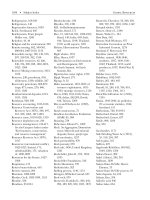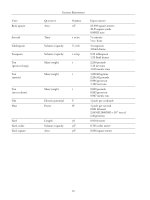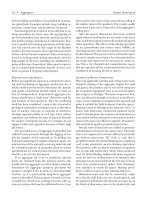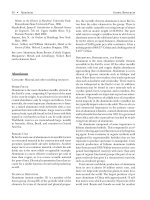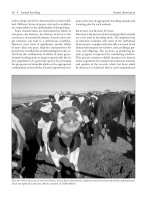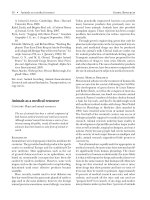Encyclopedia of Global Resources part 15 pdf
Bạn đang xem bản rút gọn của tài liệu. Xem và tải ngay bản đầy đủ của tài liệu tại đây (207.39 KB, 10 trang )
exists. The most attractive for indus
-
trial applicationsis H
2
production by
photosynthetic microbes. These mi-
croorganisms, such as microscopic
algae, cyanobacteria, and photosyn-
thetic bacteria, use sunlight as an en-
ergy sourceand water to generate hy-
drogen.
Butanol can be produced by the
fermentation of sugars similar to the
ethanol production. The most well-
known pathway of butanol genera-
tion is fermentation by bacterium
Clostridium acetobutylicum. Substrates
utilized for butanol production—
starch, molasses, cheese whey, and
lignocellulosic materials—are exactly
the same as for ethanol fermenta-
tion. The biological production by fermentation is
not economically attractive because of low levels of
product concentrations and high cost of product re-
covery compared to the chemical process.
Uses of Biofuels
With increasing energy demands and oil prices, etha-
nol has become a valuable option as an alternative
transportation fuel. The Energy Policy Act of 2005 in-
cluded a requirement to increase the production of
ethanol from 15 to 28 billion liters by 2012. Beginning
in 2008, a majority of fuel stations in the United States
were selling gasoline with 10 percent ethanol in it.
Nearly allcars can useE10, fuel thatis 10 percentetha-
nol. Blending ethanol with gasoline oxygenates the
fuel mixture, which burns more completely and pro-
duces fewer harmful CO emissions. Another environ-
mental benefit of ethanol is that it degrades in the
soil, whereas petroleum-based fuels are more resis-
tant to degradation and have many damaging effects
when accidentally discharged into the environment.
However, a liter of ethanol has significantly less en-
ergy content than a liter of gasoline, so vehicles must
be refueled more often. Ethanol is also more expen-
sive than gasoline, although rising prices of gasoline
could cancel that disadvantage. In addition, carcino-
genic aldehydes, such as formaldehyde, are produced
when ethanol is burned in internal combustion en-
gines. Carbon dioxide, a major greenhousegas, forms
as well. Moreover, the widely used fuel mix that is 85
percent ethanol and 15 percent gasoline (the E85
blend) requires specially equipped “flexible fuel” en
-
gines. In the United States, only a fraction of all cars
are considered “flex fuel” vehicles. By comparison,
however, most cars in Brazil have flex engines. Begin-
ning in 1977, the Brazilian government made using
ethanol as a fuel for cars mandatory. Brazil has the
largest and most successful “ethanol for fuel” pro-
gram in the world. As a result of this successful pro-
gram, the country reached complete self-sufficiency
in energy supply in 2006.
Biodiesel performs similarly to diesel and can be
used in unmodified diesel engines of trucks, tractors,
and other vehicles, and it is better for the environ-
ment. Burning biodiesel produces fewer emissions
than petroleum-based diesel; it is essentially free of
sulfur and aromatics and emits less CO. Additionally,
biodiesel is less toxic to the soil. Biodiesel is often
blended with petroleum diesel in different ratios of 2,
5, or 20 percent. The most common blend is B20,
or 20 percent biodiesel to 80 percent diesel fuel.
Biodiesel can be used as a pure fuel (100 percent or
B100), but pure fuel is not suitable for winter because
it thickens in cold temperatures. In addition, B100 is a
solvent that degrades engines’ rubber hoses and gas-
kets. Moreover, biodiesel energy content is less than
in diesel. In general, biodiesel is not used as widely as
ethanol. However, biodiesel users include the United
States Postal Service; the U.S. Departments of De-
fense, Energy,and Agriculture; national parks; school
districts; transit authorities; and public-utilities, waste-
management, and recycling companies across the
United States. In January, 2009, Continental Airlines
successfully demonstrated the use of a biodiesel mix
-
110 • Biofuels Global Resources
This Volvo car runs on bioethanol, a biofuel manufactured from common household
trash. (AP/Wide World Photos)
ture from plants and algae (50 percent to 50 percent)
to fly its Boeing 737-800.
In the 1985 Mel Gibson movie Mad Max Beyond
Thunderdome, a futuristic city was run on methane that
was generated by pig manure. In reality, methane can
be a very good alternative fuel. It has a number of ad-
vantages over other fuels produced by microorgan-
isms. First, it is easy to make and can be generated lo-
cally, which does not require distribution. Extensive
natural gas infrastructure is already in place to be uti-
lized. Second, the utilization of methane as a fuel is
an attractive way to reduce wastes such as manure,
wastewater, or municipal and industrial wastes. In lo-
cal farms, manure is fed into digesters (bioreactors)
where microorganisms metabolize it into methane.
Methane can be used to fuel electrical generators to
produce electricity. In China, millions of small farms
have simple small underground digesters near the
farm houses. There are several landfill gas facilities in
the United States that generate electricity using meth-
ane. San Francisco has extended its recycling pro-
gram to include conversion of dog waste into meth-
ane to produce electricity and to heat homes. With a
dog population of 120,000 this initiative promises to
generate a significant amount of fuel with a huge re-
duction of waste at the same time. Methane was used
as a fuel for vehicles for a number of years. Several
Volvo car models with bi-fuel engines were made to
runon compressed methane with gasolineas a backup.
Biogas can also be compressed, like methane, and
used to power motor vehicles.
In many countries, millions of small farms main-
tain a simple digester for biogas production to gener-
ate energy. Currently, there are more than five million
household digesters in China, used by people mainly
for cooking and lighting, and there are more than
one million biogas plants of various capacities in
India.
Utilization of methane and biogas as an energy
source in place of fossil fuels is providing significant
environmental and economic benefits. Biofuels are
essentially nonpolluting, although their utilization re-
sults in production of CO
2
and contributes to global
warming, though with less impact on Earth’s climate
than methane itself as a greenhouse gas. Even though
the use of methane and biogas as energy sources re-
leases CO
2
, the process as a whole can be considered
“CO
2
neutral” in that the released CO
2
can be assimi
-
lated by their producers, archaea and bacteria.
Some examples of biomass use as an alternative
energy source include burning wood or agricultural
residue to heat homes. This is an inefficient use of
energy—typically only 5-15 percent of the biomass en-
ergy is actually utilized. Using biomass that way pro-
duces harmful indoor air pollutants such as carbon
monoxide. Yet biomass is an almost “free” resource
costing only labor to collect. Biomass supplies more
than 15 percent of the world’s energy consumption.
Biomass is the top source of energy in developing
countries; in some countries it provides more than 90
percent of the energy used.
Hydrogen powered U.S. rockets for many years. To-
day, a growing number of automobile manufacturers
around the world are making prototype hydrogen-
powered vehicles. Only water is emitted from the tail-
pipe—no greenhouse gases. The car is moved by a
motor that runs on electricity generated in the fuel
cell via a chemical reaction between H
2
and O
2
.Hy-
drogen vehicles offer quiet operation, rapid accelera-
tion, and low maintenance costs. During peak time,
when electricity is expensive, fuel-cell hydrogen cars
could provide power for homes and offices. Hydro-
gen for these applications is obtained mainly from
natural gas (methane and propane) via steam reform-
ing. Biohydrogen is used in experimental applica-
tions only. Many problems need to be overcome be-
fore biohydrogen can be easily available. One of the
reasons for the delayed acceptance of biohydrogen
is the difficulty of its production on a cost-effective
basis. For biohydrogen power to become a reality, tre-
mendous research and investment efforts are neces-
sary.
Butanol can be used as transportation fuel. It con-
tains almost as much energy as gasoline and more en-
ergy than ethanol for a particular volume. Unlike 85
percent ethanol, a butanol/gasoline mix (E85 blend)
can beused in cars designed for gasoline without mak-
ing any changes to the engine.
Sergei A. Markov
Further Reading
Chisti, Yusuf. “Biodiesel from Microalgae.” Biotechnol-
ogy Advances 25, no. 3 (2007): 294-306.
Glazer, Alexander N., and Hiroshi Nikaido. Microbial
Biotechnology: Fundamentals of Applied Microbiology.
New York: W. H. Freeman, 2007.
Service, Robert F. “The Hydrogen Backlash.” Science
305, no. 5686 (August 13, 2004): 958-961.
Wald, Matthew L. “Is Ethanol for the Long Haul?” Sci
-
entific American 296, no. 1 (January, 2007): 42-49.
Global Resources Biofuels • 111
Wright, Richard T. Environmental Science: Towards a
Sustainable Future. 9th ed. Englewood Cliffs, N.J.:
Prentice Hall, 2004.
Web Site
AE Biofuels
o/
technology/biofuels/
See also: Brazil; Energy economics; Ethanol; Meth-
ane; Sugars; Sustainable development.
Biogeochemical cycles. See Carbon
cycle; Geochemical cycles;
Hydrology and the hydrologic
cycle; Nitrogen cycle; Phosphorus
cycle; Sulfur cycle
Biogeographic realms. See Ecozones
and biogeographic realms
Biological invasions
Categories: Environment, conservation, and
resource management; pollution and waste
disposal
A biological invasion is an enormous increase in the
numbers of a type of organism entering an ecosystem
that the organism previously was not inhabiting. The
“invading” organism may be an infectious virus, a
bacterium, a plant, or an animal.
Background
Species introduced to an area from somewhere out-
side that area are referred to as alien or exotic species
or as invaders. Because the exotic species is not native
to the new area, it is often unsuccessful in establishing
a viable population and disappears. The fossil record,
as well as historical documentation, indicates that this
is the fate of many exotic species as they move from
their native habitats to invade new environments. Oc
-
casionally, however, an invading species finds the new
environment to its liking; in this case the invader may
become so successful in exploiting its new habitat that
it can completely alter the ecological balance of an
ecosystem, destroying biodiversity and altering the lo-
cal biological hierarchy. Because of this ability to alter
ecosystems, exotic invaders are considered major
agents in driving native species to extinction and are
thought to be responsible for an estimated 40 percent
of all known extinctions of land animals beginning in
the year 1600.
Biological invasions by notorious species consti-
tute a significant component of Earth’s history. In
general, large-scale climatic changes and geological
crises are at the origin of massive exchanges of flora
and fauna. On a geologic timescale, invasions of spe-
cies fromone continent to another are true evolution-
ary processes, just as speciation and extinction are.
On a smaller scale, physical barriers such as oceans,
mountains, and deserts can be overcome by many or-
ganisms as their populations expand. Organisms can
be carried by water in rivers or ocean currents, trans-
ported by wind, or carried by other species as they mi-
grate seasonally or to escape environmental pres-
sures. However, the geological and historical records
of the Earth also show that specific biological inva-
sions by exotic species have altered the course of
world history. The extinction of genetically distinct
populations is the least reversible of all global changes,
and evidence suggests that biological invasions con-
tribute substantially to an increase in the rate of ex-
tinction within ecosystems.
Humans have transplanted species throughout his-
tory, to the point where most people are not aware of
the distinction between native and exotic species liv-
ing in their region. Recent increases in interconti-
nental invasion rates by exotic species, brought about
primarily by human activity, create important ecologi-
cal problems for the recipient lands. Among animals,
the most notorious recent invaders of North America
have been the house mouse and the Norway rat;
others include the wild boar, donkey, horse, nutria,
Pierid butterfly, house sparrow, starling, Africanized
(“killer”) bee, tiger mosquito, and red fox. One of the
most destructive invaders is the house cat. More than
seventy million domestic and feral cats live in the
United States, and they are efficient at hunting small
mammals and birds. Domestic cats are credited with
killing twenty million birdsannually in Great Britain.
It would seem logical to assume that invading spe
-
112 • Biological invasions Global Resources
cies might add to the biodiversity of a region, but
many invaders have the opposite effect. The new spe-
cies are often opportunistic and successful predators
that eliminatenative species not adapted to their pres-
ence. For example, the brown tree snake was acciden-
tally introduced to Guam during World War II as a
stowaway on military cargo ships, and the snakes have
eliminated most of the island’s birds. The snakes are
credited with the extinction of one-third of the is-
land’s native bird species, and the surviving bird pop-
ulation is so decimated that birds are rarely seen or
heard. The invasion of the brown tree snake has unal-
terably reduced the biological diversity of Guam.
Ecosystem Alteration
The invasion of an ecosystem by an exotic species
can effectively alter ecosystem processes. An invading
species does not simply consume or compete with na-
tive species but can actually change the rules of exis-
tence within the ecosystem by altering processes such
as primary productivity, decomposition, hydrology,
geomorphology, nutrient cycling, and natural distur-
bance regimes. Invading exotic species may also drive
out native species by competing with them for re
-
sources. One of the exotic invaders of the North
American continent is the zebra mussel, which came
to the United States in 1986 in the ballast water of
oceangoing vessels; it was carried from the Elbe or
Rhine River in Europe and released into the water of
the St. Clair River near Detroit, Michigan. The mussel
larvae found biological conditions in the Great Lakes
ideal. The mussel now exists in all the Great Lakes,
and after the catastrophic flood of 1993 the mussels
were sighted in the Mississippi River Basin. Mussel
density in certain locations of the Great Lakes is
known to be astonishing—greater than 94,000 indi-
viduals per square meter. In 1990, the Detroit Edison
power plant discovereda water intake pipe blocked by
a mussel population density of 700,000 mussels per
square meter. When they reach high population den-
sities, the mussels are able to filter virtually all the
larger plankton from the water. The planktonic food
chain of the Great Lakes, which supports Great Lakes
fisheries, may decline so much that higher trophic
species will be deprived of their vital plankton food
sources. The mussels also cause a demise of native bi-
valves through competition for food and because they
attach themselves to the shells of other bivalves.
Forests
The invasion of native forests by non-native insects
and microorganisms has been devastating on many
continents. The white pine blister rust and the balsam
woolly adelgid have invaded both commercial and
preserved forestlands in North America. Both exotics
were brought to North America in the late 1800’s
on nursery stock from Europe. The balsam woolly
adelgid attacks fir trees and causes death within two to
seven years by causing chemical damage and by feed-
ing on the tree’s vascular tissue. The adelgid has killed
nearly every adult cone-bearing fir tree in the south-
ern Appalachian Mountains. The white pine blister
rust attacks five-needle pines; in the western United
States fewer than 10 pine trees in 100,000 are resis-
tant, and since white pine seeds are an essential food
source for bears and other animals, the loss of the
trees has had severe consequences across the forest
food chain.
Beginning in the 1800’s the deciduous forests of
eastern North America were attacked numerous times
by waves of invading exotic species and diseases. One
of the most notable invaders is the gypsy moth, which
consumes a variety of tree species. Other invaders of
Global Resources Biological invasions • 113
The tunicate is an invasive species that grows in the habitat of
anemones and sea cucumbers. (AP/Wide World Photos)
eastern forests have virtually eliminated the once
dominant American chestnut and the American elm.
Other tree species that continue to decline because of
new invaders include the American beech, mountain
ash, white birch, butternut, sugar maple, flowering
dogwood, and eastern hemlock. It is widely accepted
that the invasion of exotic species is the single greatest
threat to the diversity of deciduous forests in North
America.
Effects on Humans, and Humans as Invaders
Some introduced exotic species are beneficial to hu-
manity. It would be impossible to support the present
world human population entirely on species native to
their regions. However, many invading species de-
grade human health and wealth, and others affect the
structure of ecosystems or the ability to maintain na-
tive biodiversity. Many invading species can act as vec-
tors of disease: Examples include bubonic plague,
vectored by rats; a host of diseases transmitted be-
tween human populations during first contacts, in-
cluding smallpox, polio, influenza, and venereal in-
fections; and malaria, dengue fever, Ross River fever,
and eastern equine encephalitis, carried by mosqui-
toes. Mosquitoes alone are thought to account for
half of all human deaths throughout history.
Humans, the ultimate biological invaders, have
been responsible for the extinction of many species
and will continue to be in the future. Like other ani-
mal invaders, humans tend to have a broad diet. Hu-
mans are also able to adapt culturally to diverse habi-
tats, an ability that complements an ability to breed all
year round. These attributes give humans a distinct
advantage overless aggressive and less destructivespe-
cies.
Randall L. Milstein
Further Reading
Burdick, Alan. Out of Eden: An Odyssey of Ecological Inva-
sion. New York: Farrar, Straus and Giroux, 2005.
Cartwright, Frederick F., and Michael Biddiss. Disease
and History. 2d ed. Stroud, England: Sutton, 2000.
Crosby, Alfred W. Ecological Imperialism: The Biological
Expansion of Europe, 900-1900. 2d ed. New York:
Cambridge University Press, 2004.
Elton, Charles S. The Ecology of Invasions by Animals and
Plants. London: Methuen, 1958. Reprint. Chicago:
University of Chicago Press, 2000.
Hengeveld, Rob. Dynamics of Biological Invasions. New
York: Chapman and Hall, 1989.
Lockwood, Julie L., Martha F. Hoopes, and Michael P.
Marchetti. Invasion Ecology. Malden, Mass.: Black-
well, 2007.
Mooney, Harold A., and James A. Drake, eds. Ecology of
Biological Invasions of North America and Hawaii.New
York: Springer, 1986.
Mooney, Harold A., and Richard J. Hobbs, eds. Inva-
sive Species in a Changing World. Washington, D.C.:
Island Press, 2000.
Nentwig, Wolfgang, ed. Biological Invasions. New York:
Springer, 2007.
Pimentel, David, ed. Biological Invasions: Economic and
Environmental Costs of Alien Plant, Animal, and Mi-
crobe Species. Boca Raton, Fla.: CRC Press, 2002.
Web Site
University of Tennessee, Department of
Ecology and Environmental Biology
Institute for Biological Invasions
See also: Genetic diversity; Pesticides and pest con-
trol; Species loss.
Biomes
Category: Ecological resources
Biomes (terrestrial and aquatic ecosystems) are distrib-
uted throughout the Earth’s surface. Terrestrial biomes
occupy the landmass from North Pole to South Pole.
Aquatic biomes occupy the bodies of water on Earth.
Background
Biomes are natural habitats for bacteria, protists,
fungi, plants, and animals. Biomes maintain the natu-
ral life cycle of these organisms and preserve the
products of geological processes on Earth. A biome is
a source of shelter, rocks and minerals, and food and
fiber for human needs.
Technical Definition
A terrestrial biome is a large ecosystem characterized
by a particular type of climate and soils with defined
groups of highly adapted living organisms. Biome for-
mation is influenced by warm temperature and heavy
precipitation in the tropics and extreme cold and low
precipitation near the poles. Most ecologists do not
114 • Biomes Global Resources
consider aquatic ecosystems as biomes and refer to
them as “aquatic biomes,” which are classified based
on the concentration of dissolved salts: less than 0.1
percent in freshwater biomes, 0.1 to 1.0 percent in es-
tuaries, and more than1.0 percentin marine biomes.
Climate and Biomes
Climate shapes terrestrial biomes. Climate is predom-
inantly driven by the solar energy and atmospheric
circulation. Air circulation is initiated at the equator,
because the equator receives the greatest solar energy
with the warmest air near the ground. Because of dif-
ferent air densities, warm air in the troposphere rises
into the stratosphere and cools. Cool air in the strato-
sphere descends into troposphere and warms. This
rise and fall pattern of circulating air starts at 0°
(equator) to 30° latitude, then continues at 30° to 60°
latitude, and ends at 60° to 90° latitude (poles).
There are six major atmospheric circulations:
Three move from the equator to the North Pole; the
other three move from the equator to the South Pole.
At 0° latitude, the ascending warm, humid air from
the troposphere cools and condenses as it reaches the
stratosphere, releasing heavy rain to or near the equa-
tor. That the dominant biomes formed at the equator
are the tropical rain forests is no accident. After re-
leasing rain, the cool, dry air moves poleward and de-
scends at 30° latitude. The descending cool, dry air
becomes warm as it reaches the troposphere and then
absorbs all the available moisture. Not surprisingly,
the dominant biomes at 30° latitude are the deserts,
where the warm, humid air splits. One air mass moves
equatorward to recirculate at 0° latitude. The other
moves poleward and rises at 60° latitude, releasing rain
or snow while at the stratosphere. As a result, the dom-
inant biomes at 60° latitude are the temperate forests
and temperate grasslands. The cool, dry air at the
stratosphere divides again 60° latitude. One air mass
moves toward 30° latitude to descend and recirculate
in the desert. The other moves poleward, then de-
scends and releases the remaining moisture near the
poles, where the arctic tundra biomes are formed.
Terrestrial Biomes
The are nine major terrestrial biomes.
Arctic Tundra. Arctic tundra is located in the
Northern Hemisphere near the North Pole and cov-
ers 20 percent of Earth’s landmass. It has extremely
long, freezing, and harsh winters, with very short (six-
to eight-week) summers. It is considered “cold desert,”
because it receives 20 centimeters of precipitation per
year. Melting snow creates bogs in summer, but there
are frozen layers of subsoil (permafrost) at least a
meter deep that exist throughout the year. Soil is
nutrient-poor. Only the low-growing grasses and
dwarf woody shrubs adapted to extreme cold and a
short growing season are found. No trees survive.
Their roots cannot penetrate the permafrost. Few ani-
mal species live in tundra. In winters, ptarmigans,
musk oxen, snowy owls, lynxes, arctic foxes, and snow-
shoe hares are found. Polar bears are common in the
coastal regions. In summers, few migrating animals
from taiga move to tundra. No reptiles are found, but
mosquitoes survive.
Taiga. Taiga, also called boreal coniferous forest,
exists south of tundra and covers 11 percent of the
Earth’s land surface. It is found in the northern parts
of North America and Eurasia and along the Pacific
coast ofnorthern North America to Northern Califor-
nia. It has patchy and shallower permafrost than tun-
dra, and has acidic, nutrient-poor soil. It has short
summers and long, cold winters and receives 50 centi-
meters precipitation per year. Evergreen conifers are
adapted to these conditions, with low-lying mosses
and lichens beneath the forest canopy. Seeds of coni-
fers attract birds. Bears, deer, moose, beavers, musk-
rats, wolves, mountain lions, and wolverines inhabit
the taiga.
Temperate Rain Forest. Temperate rain forest, a
coniferous forest, stretches along the west coast of
Canada and the United States, the southeast of Aus-
tralia, and the south of South America. It has dense
fog, mild winters, cool summers, and high annual pre-
cipitation of 250 centimeters. With abundant rain and
nutrient-rich soil, the temperate rain forests have re-
tained some of the tallest conifers (such as coastal red-
woods) and oldest trees, some as old as eight hundred
years. Moisture-loving plants (mosses and ferns) grow
on the tree trunks of evergreen conifers. Temperate
rain forest is a habitat for squirrels, lynxes, and several
species of amphibians, reptiles, and birds (such as the
spotted owl).
Temperate Deciduous Forest. Temperate decid-
uous forest is located south of the taiga in eastern
North America, eastern Asia, and much of Europe.
Temperate deciduous forests have a moderate cli-
mate, with occasional hot summers and cold winters
and high annual precipitation of 75 to 150 centime
-
ters. They have long growing seasons ranging from
140 to 300 days. The soil is rich in minerals. The domi
-
Global Resources Biomes • 115
nant trees are deciduous (oak, beech, sycamore, and
maple), which shed their broad leaves in the fall and
grow them in the spring. Under the forest’s canopy,
understory trees and shrubs are found. Layers of
growth in the forest are home for several insects and
birds. Groundanimals include rabbits,squirrels, wood-
chucks, chipmunks, turkeys, beavers, and muskrats.
Temperate Grasslands. Temperate grasslands in-
clude the South American pampas, the Russian
steppes, and the North American prairies. Tall-grass
prairies are found between Illinois and Indiana,
whereas short-grass prairies extend from Texas to
Montana and North Dakota. They have hot and dry
summers and bitterly cold winters, with annual pre-
cipitation of 25 to 75 centimeters. Grasses in these
biomes produce a deep, dark, mineral-rich soil. Her-
bivore mammals (bison, pronghorn antelope, mice,
prairie dogs, and rabbits) dominate the temperate
grasslands. Hawks, snakes, badgers, coyotes, and foxes
are the predators in this biome.
Shrubland. Shrubland, or chaparral, is composed
of thickets of small-leaf evergreen shrubs (shorter
than trees and without main trunks). Shrublands,
with frequent fires in dry summers and winters of 25
to 75 centimeters of rain annually, are found along
the cape of South Africa, the western coast of North
America, the southwestern and southern shores of
Australia, around the Mediterranean Sea, and in cen-
tral Chile. The shrubland in California is called chap-
arral, because it lacks understory. Shrubs are fire-
adapted and highly flammable. The seeds of many
species require the scarring action of fire to induce
germination. Other shrubsresprout fromthe rootsaf-
ter fire. Mule deer, rodents, scrub jays, and lizards in-
habit the shrublands.
Deserts. Deserts exist near or at 30° north and
south latitudes and cover approximately 30 percent of
the Earth’s land surface. The dry air that descends in
this region absorbs most of the available moisture,
then moves away to the equator and to 60° latitude.
Deserts receive less than 25 centimeters of rain annu-
ally. The Sahara Desert of Africa and the Arabian
Peninsula and the deserts of North America (Mojave,
Chihuahuan, and Sonoran) have little or no vegeta-
tion. Organisms with specialized water-conserving
adaptations survive, including cactus, agave, Joshua
trees, and sagebrush plants. Hawks prey on lizards,
snakes, roadrunners, and kangaroo rats.
Tropical Grasslands. Tropical grasslands, or sa
-
vannas (such as African savannas), characterized by
widespread growth of grasses with few interspersed
trees, are found in areas with seasonal low rainfall and
prolonged dry periods. Other savannas occur in
South America and northern Australia. Savanna has
an annual precipitation of 25 to 75 centimeters. Sa-
vanna soil is nutrient-poor.Acacia trees survive the se-
vere dry season. Hoofed herbivore mammals (giraffes,
elephants, zebras, and rhinoceroses) feed on tree veg-
etation and on grasses. Carnivores such as hyenas,
lions, cheetahs, and leopards prey on herbivores.
Tropical Rain Forests. Tropical rain forests are
located in South America, Africa, Southeast Asia, and
the Indo-Malayan region on or near the equator. Wet
and dry seasons are warm year-round. Annual rainfall
is 200 to 450 centimeters. Tropical rain forest soil is
typically nutrient-poor, but plentiful rain supports the
growth of diverse groups of woody and herbaceous
plants. Some of the rains come fromrecycled water re-
leased by forest trees by transpiration. Of all the
biomes, tropical rain forest is the richest, based on
species diversity, productivity, and abundance of all
organisms. Tropical rain forest has three levels: the
canopy (the highest layer of the forest), the under-
story (middle layers of small trees and shrubs), and
forest floor (ground layers of herbaceous plants).
Epiphyte plants (such as bromeliads, orchids, ferns,
and Spanish moss) gain access to sunlight by growing
on trunks and branches of tall trees. Lemurs, sloths,
and monkeys are tree-dwelling primates that feed on
fruits. The largest carnivores in the tropical rain forest
are the jaguars in South America and the leopards in
Africa and Asia.
Aquatic Biomes
All aquatic biomes share three ecological groups of
organisms: the plankton, nekton, and benthos. Plank-
ton are classified into microscopic phytoplankton
and large zooplankton. Phytoplankton are producers
and include photosynthetic cyanobacteria and free-
floating algae, which provide oxygen and food for
heterotrophic organisms. Zooplankton are consum-
ers, heterotrophic, nonphotosynthetic organisms that
include protozoa, small crustaceans, and larvae of
aquatic animals. Nekton are larger swimming ani-
mals such as turtles, fishes, and whales. Benthos are
bottom-dwelling animals that attach themselves to
a substratum (sponges, oysters, and barnacles), bur-
row themselves into soil (clams, worms, and echi
-
noderms) or simply swim or walk on the bottom (cray
-
fish, crabs, lobsters, insect larvae, and brittle stars).
116 • Biomes Global Resources
Based on salt contents, the three major aquatic eco
-
systems are the freshwater, estuary,and marine ecosys-
tems. Freshwater ecosystems, which contain less than
0.1 percent dissolved salts and occupy about 2 percent
of theEarth’s surface,include flowing waters (streams
and rivers), standing waters (ponds and lakes), and
freshwater wetlands (marshes and swamps). While all
freshwater habitats provide homes for animal species,
greater vegetations are found in marshes (grasslike
plants) and in swamps (trees and shrubs) than in flow-
ing- and standing-water ecosystems. Estuaries occur
where fresh water and salt water meet, with salt con-
centrations of 0.1 to 1.0 percent. Temperate estuaries
called salt marshes are dominated by salt-tolerant
grasses. Tropical estuaries are called mangrove for-
ests. Marine ecosystems, which contain more than
1.0 percent dissolved salts, dominate, occupying about
70 percent of the Earth’ssurface. Marine biomes have
three zones: the intertidal, pelagic, and benthic zones.
The intertidal zone is the shoreline area between low
and high tide. The pelagic zone is the ocean water
(shallow ordeep), where plankton and swimming ma-
rine organisms are found. The benthic zone is the
ocean floor, where marine animals burrow. Coral
reefs, kelp forests, and seagrass beds are part of the
benthic zone.
History
The existence of aquatic and terrestrial ecosystems
was discoveredthrough fossil records.Aquatic biomes
emerged before the terrestrial biomes. Approximately
542 million years ago, during the Cambrian period,
organisms in marine biomes became diversified and
included bacteria, cyanobacteria, algae, fungi, ma-
rine invertebrates, and first chordates. The first ter-
restrial biome existed when the first forest and gym-
nosperm appeared about 416million years ago, during
the Denovian period. About 359 million years ago,
during the Carboniferous period, the formation of
much more diversified forest occurred, which con-
sisted of ferns, clubmosses, horsetails, and gymno-
sperms and which housed many insects, amphibians,
and first reptiles. Flowering plants (angiosperms) later
evolved and became the dominant organisms of most
major biomes.
Domingo M. Jariel
Further Reading
Kirchner, Renee. Biomes. Detroit: KidHaven Press/
Thomson Gale, 2006.
Roth, Richard A. Freshwater Aquatic Biomes. Westport,
Conn.: Greenwood Press, 2009.
Solomon, Eldra Pearl, Linda R. Berg, and Diana W.
Martin. “Ecology and the Geography of Life.” In Bi-
ology.8th ed. Monterey, Calif.: Brooks/Cole,2008.
Woodward, Susan L. Marine Biomes. Westport, Conn.:
Greenwood Press, 2008.
Web Site
University of California Museum of
Paleontology
/>index.php
See also: Biodiversity; Biosphere;Biosphere reserves.
Biopyriboles
Category: Mineral and other nonliving resources
Biopyriboles are minerals composed of linked silicate
groups. Some hard biopyriboles are used as gemstones.
Fibrous biopyriboles are used to manufacture asbestos.
Micas are used in electrical components and as fillers,
absorbents, and lubricants. Clays are used in bricks,
pottery, and fillers.
Definition
Biopyriboles are a large and varied group of minerals
in which silicate groups (one silicon atom bonded
to four oxygen atoms) are linked together in one-
dimensional chains (either single chains or two
chains linked together) or two-dimensional sheets.
Those with chains are usually hard, while those with
sheets are usually soft. Hard biopyriboles are usually
found as separate minerals within igneous and meta-
morphic rocks. Soft biopyriboles are usually found as
flakes of mica within rocks or as particles of clay in
soils and freshwater sediments.
Overview
There are three broad categories of biopyriboles,
depending on whether the silicate groups are linked
together into single chains, double chains, or sheets.
Single-chain biopyriboles are known as pyroxenes.
Double-chain biopyriboles are known as amphiboles.
Together these two subgroups are known as pyriboles
or inosilicates. Sheet biopyriboles are known as
Global Resources Biopyriboles • 117
phyllosilicates. The word “biopyribole”
is a combination of “biotite” (a common
phyllosilicate), “pyroxene,” and “amphi-
bole.”
Pyroxenes are composed ofchains of
silicate groupscombined with a wide va-
riety of other atoms, including sodium,
magnesium, calcium, iron, and alumi-
num. They are generally fairly hard min-
erals with a density between three and
four grams per cubic centimeter. Pyrox-
enes are usually dark green or black,
but other colors also exist. The most
common pyroxene is augite, a green or
black mineral sometimes used as a gem-
stone. Spodumene is a white, light gray,
or light yellow pyroxene that contains
lithium. It is the most important source
of that element. Jadeite, a type of jade, is a green py-
roxene used as a gemstone.
Amphiboles are composed of two linked chains of
silicate groups combined with the same variety of at-
oms as those found in pyroxenes. They also contain
hydroxyl groups (one oxygen atom bonded to one hy-
drogen atom), which cause them to release water
when heated. At high temperatures the double chains
break down into single chains to form pyroxenes. Am-
phiboles are fairly hard minerals with a density be-
tween 2.9 and 3.6 grams per cubic centimeter. The
most common amphibole is hornblende, a dark green
or black mineral. Nephrite, a green amphibole, is a
form of jade.
Phyllosilicates are composed of sheets of silicate
groupscombined with thesame kindsof atoms asthose
118 • Biopyriboles Global Resources
Augite is the most common pyroxene, a type of biopyribole. (USGS)
Biopyribole Categories
Examples
Sheet silicates
Brittle mica group —
Chlorite —
Clays Kaolinite, smectite,
illite
Serpentine Antigorite, chrysotile
asbestos
Talc Talc, pyrophyllite
Mica Biotite, moscovite
Chain silicates
Single silica tetrahedron
chains:
Monoclinic alkali
pyroxenes
Jadeite
Examples
Monoclinic calcic
pyroxenes
Diopside, augite
Orthorhombic
pyroxenes
Enstatite, hypersthene
Pyroxenoids Wollastonite
Double silica tetrahedra
chains:
Monoclinic alkali
amphiboles
Glaucophane,
riebeckite
Monoclinic calcic
amphiboles
Tremolite, hornblende
Monoclinic magnesium-
iron amphiboles
Cummingtonite
Orthorhobmic
amphiboles
Anthophyllite
found inpyriboles. Most phyllosilicates are softminer
-
als witha density between 2 and 3 grams per cubic cen-
timeter. Talc,alight-colored, very soft phyllosilicate, is
used in paint, ceramics, and talcum powder. Serpen-
tine, a green, fibrous mineral, is used to make asbestos.
Many phyllosilicates exist as clays, used in ceramics
and fillers, or asmicas, used in electrical components.
Rose Secrest
See also: Asbestos; Clays;Gems; Mica; Silicates; Talc.
Biosphere
Category: Ecological resources
The biosphere is the relatively thin layer around the
Earth’s surface where life is naturally possible. The
concept is important in ecology for the calculation of
energy and mineral resource budgets, in space explora-
tion for the establishment and maintenance of livable
environments for space travelers, and perhaps for un-
derstanding the possibilities for life on other planets.
Background
The first use of the term “biosphere” dates to 1875,
when geologist Eduard Suess described layers of the
Earth in his book on the origin of the Alps. The Rus-
sian geologist Vladimir Vernadsky popularized the
term in hislectures, published in French in 1929 as La
Biosphere. Vernadsky noted that the concept, although
not the term, had originated much earlier with the
Frenchbiologist Jean-Baptiste Lamarck(1744-1829).
Extent of the Biosphere
Although most people would think nothing of travel-
ing 50 kilometers to a nearby town, journeying up-
ward far less than this distance would mean certain
death without a special support system. As altitude in-
creases, decreases in pressure, vital gases, and temper-
ature prevent active metabolism. However, dormant
bacterial and fungal spores can apparently drift up-
ward indefinitely in this “parabiosphere.” Most jet
plane passengers are aware that artificial cabin pres-
sure is required to sustain them in the thinning atmo-
sphere when they are only a few kilometers high.
Chlorophyll plants cannot live above about 6,200 me
-
ters because all water freezes at that altitude and the
carbon dioxide available for photosynthesis is at less
than half that available at sea level. The few spiders
and springtails that live on top of Mount Everest sur-
vive on plant and animal debris blown up there by
wind currents.
Life also extends downward into the deepest ocean
trenches, although the density of organisms is drasti-
cally less in the dark zones beneath the thin top layer,
where sunlight feeds algae and the resultant food
chains. Most deep-ocean organisms must feed on the
rain of organic matter that sinks from the surface or
feed in the detritus food chain. Many organisms live
on the surface of the ocean bottom, and sampling
studies have shown that life extends deep into these
bottom muds. Not all organisms here derive their en-
ergy indirectlyfrom plant photosynthesis;some thrive
on food chains originating with sulfur bacteria. Or-
ganisms that have evolved to live under the tremen-
dous water pressure of the lower oceans burst open
if pulled to the surface; conversely, humans would
be crushed at these depths, so exploration requires
heavy protective equipment. Like deep-ocean fish
brought to the surface, humans decompress when ex-
posed at high altitudes. Therefore, much of the bio-
sphere is beyond humans’ day-to-day reach.
Biomes
The terrestrial part of the biosphere can be subdi-
vided into such categories as hot and wet tropical rain
forests, frozen arctic tundra, coldmountaintop mead-
ows, and prairie grasslands. These natural communi-
ties with similar plants and animals are called “bi-
omes.” For example, conifer forests stretch around
the upperlatitudes of Canada, Europe, and Russia. Al-
though the species of conifer trees, large grazers, and
predators differ, the ecology is very similar. The same
is true for the grassland biome that occurs in the U.S.
plains states, Russia, Argentina, and South Africa, and
the temperate deciduous forests of the eastern
United States, Europe, and China. Other biomes in-
clude taiga, savanna, thornbush, chaparral, and vari-
ous tropical rain forest types.
The first breakdown of biotic communities was
made by C. Hart Merriam, working in 1890 in Califor-
nia and Arizona; his “vegetative life zones” were based
on temperature and ignored rainfall. Victor E. Shel-
ford added detailed descriptions of animal associa-
tions but did not try to correlate communities with cli-
mate. While Shelford’s followers consider biomes to
be distinct entities, other ecologists view them as hu
-
man concepts that hide the fact that communities
Global Resources Biosphere • 119
